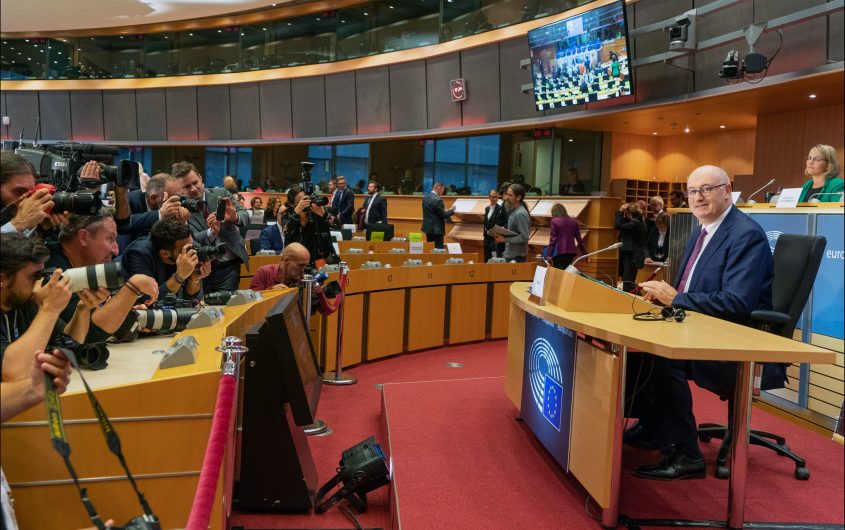
CC-BY-4.0: © European Union 2019 – Source: EP via Flickr
Rethinking U.S.-EU Trade: From FTA to SEA

Peter S. Rashish
Vice President; Director, Geoeconomics Program
Peter S. Rashish, who counts over 30 years of experience counseling corporations, think tanks, foundations, and international organizations on transatlantic trade and economic strategy, is Vice President and Director of the Geoeconomics Program at AICGS. He also writes The Wider Atlantic blog.
Mr. Rashish has served as Vice President for Europe and Eurasia at the U.S. Chamber of Commerce, where he spearheaded the Chamber’s advocacy ahead of the launch of the Transatlantic Trade and Investment Partnership. Previously, Mr. Rashish was a Senior Advisor for Europe at McLarty Associates, Executive Vice President of the European Institute, and a staff member and consultant at the International Energy Agency, the World Bank, UN Trade and Development, the Atlantic Council, the Bertelsmann Foundation, and the German Marshall Fund.
Mr. Rashish has testified before the House Financial Services Subcommittee on International Monetary Policy and Trade and the House Foreign Affairs Subcommittee on Europe and Eurasia and has advised three U.S. presidential campaigns. He has been a featured speaker at the Munich Security Conference, the Aspen Ideas Festival, and the European Forum Alpbach and is a member of the Board of Directors of the Jean Monnet Institute in Paris and a Senior Advisor to the European Policy Centre in Brussels. His commentaries have been published in The New York Times, the Financial Times, The Wall Street Journal, Foreign Policy, and The National Interest, and he has appeared on PBS, CNBC, CNN, NPR, and the BBC.
He earned a BA from Harvard College and an MPhil in international relations from Oxford University. He speaks French, German, Italian, and Spanish.
Phil Hogan, the new European Commissioner for Trade, is traveling to Washington this week to seek a “reset of the EU/US trade relationship,” which has been under strain. President Trump called the EU “a foe” for its trade surplus with the U.S., imposed tariffs on steel and aluminum imports, and threatened to do the same for cars and car parts. This year the White House is targeting France’s digital services tax on companies like Google and Amazon and the longstanding Boeing-Airbus dispute is reaching its endgame.
U.S.-EU trade ties would certainly benefit from a more collaborative approach. But as has been clear at least since the renegotiation of the North American Free Trade Agreement (NAFTA) completed last year, trade policy more broadly needs a new narrative. Given that the transatlantic trade and investment relationship is the world’s most important, the U.S. and the EU can take the lead in rebooting the way countries think and talk about trade.
Given that the transatlantic trade and investment relationship is the world’s most important, the U.S. and the EU can take the lead in rebooting the way countries think and talk about trade.
Since the signing of NAFTA in 1993 there has been a striking evolution in the branding of trade policy. While other “free trade agreements” have entered into force, many deals since then have jettisoned the clear and simple idea of free trade for something else.
The EU has established partnership arrangements with its former colonies, while the U.S. negotiated the “Trans-Pacific Partnership” with 11 other countries that the Trump administration withdrew from in early 2017. From 2013 the U.S. and the European Union were in talks to create the world’s largest free trade zone through the “Transatlantic Trade and Investment Partnership” until it dissolved over differences in the fall of 2016.
For both the U.S. and the EU, using the term “partnership” often signaled the special political significance involved in these agreements. But it also was a way to avoid the term “free trade.” Starting with the financial crisis of 2008, free trade—along with other aspects of globalization like the spread of new technologies and rising migration flows—has been under attack for contributing to economic unfairness within and between countries.
With NAFTA’s successor, the U.S.-Mexico-Canada Agreement (or USMCA), there is neither partnership nor free trade nor anything else to suggest what its purpose is. But at least it has a name: the limited talks underway between the U.S. and the EU since July 2018 covering industrial tariffs and regulatory cooperation remain unidentified.
If a trade agreement is worth doing, its purpose should be stated at the outset and be easily understandable from its name.
When Commissioner Hogan sits down with U.S. Trade Representative Robert Lighthizer they can take a new approach. Rather than a return to “free trade” or “partnership,” they should commit to negotiating a transatlantic “Strategic Economic Agreement” or SEA.
A Strategic Economic Agreement would communicate that trade policy’s most vital function today is to shape the global economic environment in a way that serves transatlantic interests.
A Strategic Economic Agreement would communicate that trade policy’s most vital function today is to shape the global economic environment in a way that serves transatlantic interests. In the long run, without the right rules to govern how trade and investment take place, the traditional goal of trade policy—lifting economic growth—will be compromised.
In contrast to China, the U.S. and the EU share a commitment to the rule of law, the market economy, fairly regulated competition, high standards for workers, and artificial intelligence serving the individual rather than the state. Tariff reduction and regulatory alignment are valuable, but they need to take a back seat to the more urgent task of signing a U.S.-EU Strategic Economic Agreement.








